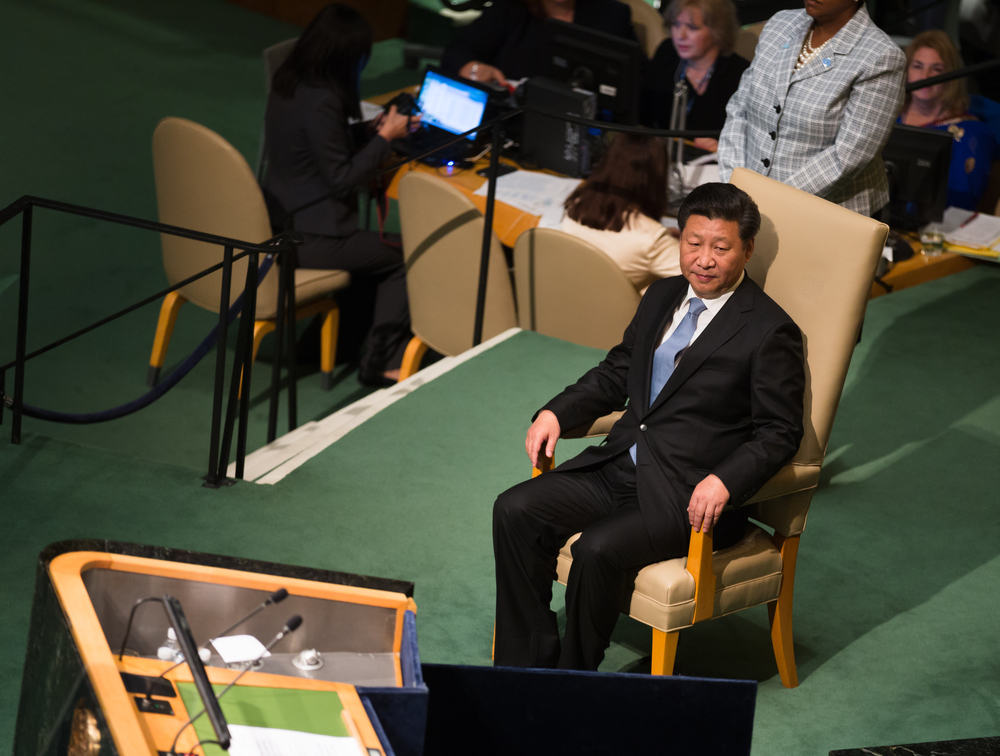by John Feffer
At its best, the earth was once likened to a spaceship that sails through the heavens with a crew working together for the common good. Thanks to climate change, this metaphor no longer works. Our planet is now more like a lifeboat that’s sprung a major leak. People onboard are beginning to panic and the clock is ticking.
It is, however, the perfect environment to test out the best way to deal with life-and-death situations.
For such a test, imagine not one but two lifeboats of survivors bobbing in an endless, empty sea. Both contain the same number of people and a limited amount of food. Based on some educated guesses by one knowledgeable crewmember, the boats are at least five days from land, if everyone rows together and they don’t veer off course.
In the first boat, the survivors debate the problem: Should they stay in place and conserve their energy or strike off in search of land? They divide into three committees to address the different aspects of the problem and present their findings, making sure everyone has input. They debate for hours, growing weaker and weaker until they no longer have the energy to do anything and the issue decides itself.
In the second boat, one person takes control, believing he alone has the skill and knowledge to steer the lifeboat toward land. Not everyone agrees, but dissenters are silenced. The others agree that there’s no time for more discussion. The new leader imposes rules on who rows and who eats. When someone falls deathly ill, he orders the incapacitated man thrown overboard.
The second lifeboat is moving at a good pace — but is it going in the right direction?
On Lifeboat Earth, time and resources are similarly limited. According to most climate scientists, the window of opportunity to prevent irrevocable climate change is about a dozen years. Opinion is divided, however, on how to address this problem with the urgency it requires.
The international community has tried, in a roughly democratic fashion, to avoid the apocalypse. In 2015, the countries of the world came together in Paris and negotiated a non-binding climate accord that was a victory for compromise but a failure for shrinking the planet’s actual carbon footprint. In a number of countries around the world, democratic elections subsequently brought climate-change deniers like Donald Trump to power, further compromising that accord.
In this way, the planet risks following the first lifeboat scenario: talking ourselves to death.
The second lifeboat option — think of it as eco-authoritarianism — seems to better fit the temper of the times. The current climate emergency coincides with a profound disillusionment with the liberal world order. Authoritarianism has become significantly more popular these days, even in otherwise democratic societies like India, Brazil, and the United States.
Droves of voters have abandoned mainstream parties across the planet, disillusioned by the way they’ve supported a version of economic globalization that has wildly enriched the already rich, challenged the middle class, and left the poor at the bottom of the barrel. Those voters have increasingly turned to right-wing populists who disparage “globalists” and promise swift action on a range of issues from immigration to crime.
Such authoritarians couldn’t, of course, be less “eco.” Most of them deny that climate change is even a problem and some, like Donald Trump, are working with the giant energy companies to heat the planet faster. They’ve commandeered the lifeboats, only to steer them ever further from possible rescue.
Feckless democrats or reckless authoritarians: Lifeboat Earth doesn’t stand much of a chance with such options.
It’s no wonder that China has emerged as a last hope for those frustrated by the torpor of the international community and the delusions of the axis of denial. Hasn’t that country, after all, redirected enormous streams of funding into sustainable energy? Wasn’t that state’s coercive one-child policy a critical way to address overpopulation and, by extension, the consumption of resources? Hasn’t China stepped ever more firmly into the international leadership void created by Trump’s nationalist retreat? As in the second lifeboat scenario, however, China may not be heading in the right direction.
So there we are: 12 years, leaky lifeboats, and no safe haven in sight.
The Ongoing Tragedy of the Commons
In the early 1970s, after the world’s first Earth Day, the lifeboat problem seemed to be on everyone’s mind. When an oil crisis hit in 1973, energy suddenly no longer seemed like an inexhaustible resource. Overpopulation was threatening to outstrip food production. Pollution darkened the skies over major cities and industrial effluents befouled the waters. Environmentalists were having a field day exposing the ruthless exploitation of resources at the heart of both the capitalist and the communist systems.
Almost half a century ago, some visionary thinkers were already worrying about climate change. In An Inquiry into the Human Prospect in 1973, political scientist Robert Heilbroner delineated the various environmental challenges facing the world, including “global thermal pollution,” before concluding that only a combination of military discipline and religious faith could transform the social order.
Fellow political scientist William Ophuls, writing in 1973, posed the problem even more starkly as “Leviathan or oblivion.” Either humanity would opt for a “government with major coercive powers” to preserve the environment or it might as well give up. Several years later, he applied his argument to international relations as well, writing, “The already strong rationale for a world government with enough coercive power over fractious nation states to achieve what reasonable men would regard as the planetary common interest has become overwhelming.”
No such world government, of course, ensued. The international authorities that did exist at the time proved to have neither the coercive power nor the will necessary for the task. In 1979, however, scientists from 50 nations did gather in Geneva for the first World Climate Conference to issue a call for action on global warming. Later that year, the leaders of the seven richest countries on the planet actually agreed on the need to reduce carbon emissions (something long forgotten in the twenty-first century). Those 1979 meetings began what Nathaniel Rich describes in his article (and now book) Losing Earth as the decade of missed opportunities in the fight against climate change. In 1989, diplomats from 60 countries finally gathered to pass a binding treaty on the subject. “Among scientists and world leaders, the sentiment was unanimous,” Rich writes. “Action had to be taken and the United States would need to lead. It didn’t.”
Here was a vivid early display of that first lifeboat scenario: much talk, no action.
Those early efforts to grapple with climate change were all a response, in different ways, to what ecologist Garrett Hardin had called the “tragedy of the commons.” In a famous 1968 essay, he described an age-old problem: herders let their few cattle graze in a common pasture without thinking much about the future; there comes a time, however, when the livestock multiply or more farmers are attracted to the pasture by the rumor of free fodder and, sooner or later, all the grass is eaten, the topsoil blows away, and the field falls into ruin.
To prevent such a scenario, an intervention is obviously necessary. According to enthusiasts for laissez-faire capitalism, the invisible hand of the market should solve the problem, with the field being sold to the highest bidder. Fans of Soviet-style communism argued that nationalizing the property would ultimately protect it. As it turned out, neither capitalism nor communism had much of a track record when it came to protecting that commons. The invisible hand proved not to have a green thumb and neither did the all-too-visible hand of state planning.
Still, in the 1970s, it was commonplace to assume that the two systems would sooner or later converge at some social democratic point on the far horizon. On the environment, in other words, two wrongs would somehow make a right. In their 1974 book Ark II, Dennis Pirages and Paul Ehrlich proposed adding a “planning branch” to the U.S. government that could address systemic problems like the environmental crisis by developing not only five-year plans, as in the Soviet Union, but 10-year or even 50-year plans as well.
Instead, Americans — and the rest of the world — ran screaming in the opposite direction. The debate in the 1970s about the possible use of state power to deal with pressing environmental concerns gave way in the 1980s and 1990s to the mania of U.S. President Ronald Reagan and British Prime Minister Margaret Thatcher for an unfettered capitalism in which state planning would be a no-no (outside the Pentagon). Meanwhile, increased yields from industrial agriculture, modest environmental reforms by the major powers, and the technological advances that made globalization possible all seemed to diminish the urgency of the environmental crisis (except among environmentalists). Long lines at gas stations were a thing of the past and the air above most cities became clearer, while the world community dodged the bullet of ozone depletion through a rare instance of global cooperation. Spaceship Earth seemed to be motoring along quite well enough, thank you very much.
But there was one niggling detail that even eco-optimists could no longer ignore. Global temperatures were continuing to rise in a dramatic fashion, a problem impermeable to modest policy adjustments, free-market solutions, or even, it seemed, global agreements. Talking about climate change didn’t make climate change go away.
And so Leviathan has returned.
“Even the best democracies agree that when a major war approaches, democracy must be put on hold for the time being,” scientist James Lovelock said in 2010. “I have a feeling that climate change may be an issue as severe as a war.” A slew of books in recent years have addressed the question of whether democracy can handle climate change. In Climate Leviathan, political theorists Geoff Mann and Joel Wainwright suspected that William Ophuls was prophetic, that a powerful hegemon would “seize command, declare an emergency, and bring order to Earth, all in the name of saving life.” In The Climate Change Challenge and the Failure of Democracy, David Shearman and Joseph Wayne Smith identified the possible solution as a Singaporean one: rule by an enlightened class of technocratic mandarins.
Not everyone, however, was so quick to give up on democracy. Libertarians, liberals, and radicals all rejected the eco-authoritarian option. Libertarians worried about limitations on individual rights. Liberals pointed out that only democracies can hold their leaders accountable for the direction they take, while “real existing authoritarianism” generally can’t. Radicals like environmentalist Naomi Klein urged not less but more democracy as climate activists, through pipeline blockades and fracking protests, challenged the nexus of transnational corporations and corrupt governments.
As in the 1970s, however, the international community has continued to prove far too weak to enforce anything, while the effects of climate change in the form of extreme weather, stunning heat waves, increasing inundations, and expanding wildfire seasons make themselves ever more evident.
Meanwhile, the United States, particularly under Donald Trump, is utterly uninterested in leading the way on reducing carbon emissions. So, there’s really only one viable candidate for a Climate Leviathan today.
China and Climate Change
Two weeks after the Tiananmen Square crackdown on June 4, 1989, 30 top leaders of the Chinese Communist Party gathered to endorse the government’s violent response to protestors. Previously, there had been profound disagreements in the Party over how to deal with the protest movement — and with the reform process more generally. After the tragedy of June 4th, a new consensus emerged among that country’s powerbrokers: China needed one strong leader, a “great helmsman” in the tradition of Mao Zedong who could eliminate factionalism.
Prescribing a solution to China’s leadership problems was one thing, filling that prescription something else entirely. The country’s post-Tiananmen leaders — Jiang Zemin and Hu Jintao — were not exactly helmsman material. Within years, China was adrift, without a grand strategy or strong coordination from above.
Then, in 2012, along came Xi Jinping. In the years that followed, on the domestic side, he would promote a “Chinese dream” of economic prosperity and national dignity restored, a kind of Make China Great Again program. In foreign policy, he would unveil a Belt and Road Initiative to build infrastructure by land and sea to grow the economies of China’s neighbors, while making Beijing ever more central to markets ever farther afield.
Here was a Leviathan in the making: a strong, centralized state no longer hobbled by intra-party disputes, no longer paralyzed by contending public interests or movements in the streets demanding their rights. As the country’s president, Xi showed no hesitation about seizing control of the helm of state. After consolidating his power through anticorruption purges, he declared himself leader for life in 2018.
Meanwhile, he continued to redirect vast sums into renewable energy. By 2017, the government was planning to devote $360 billion to it through 2020, creating 13 million new jobs in that sector. China has in these years installed more solar panels and wind power generators than any other country on Earth, approximately three times those of second-place America. It leads in the production and export of most of the key components of a clean-energy future, from wind turbines to electric vehicles. Even more telling is how many renewable energy patents China has registered: 150,000. Number two again is the United States with around 100,000.
So, China has emerged as a seemingly capable Leviathan, combining state planning with a fervent embrace of market forces to fulfill the dreams of the convergence theorists of the 1970s, while creating a strong set of domestic incentives in favor of renewable energy.
Unfortunately, however, the Chinese solution looks like anything but a successful eco-authoritarian way to go, in part because Beijing is using its Belt and Road Initiative to maintain an unsustainable environmental status quo on an increasingly planetary scale. It matters little that Xi Jinping has labeled the massive project green and sustainable. The record so far suggests quite another story. For instance, China is now building or planning to build 300 coal-fired plants abroad as part of its global infrastructure push, even as it cuts down modestly on state contracts for similar plants at home. Beijing, it turns out, also has to deal with its equivalent of the West Virginia coal industry and is rewarding it with international contracts galore.
But coal plants are only the most obvious part of the problem. All the roads that China is building will be filled with motorists and truckers. All its new and refurbished ports will host huge gas-guzzling ships. Some of its projects threaten carbon-absorbing forests and other delicate ecosystems. And then there’s China’s not-so-hidden desire to use all of this future infrastructure to gain access to raw materials. In Africa alone, China is now investing more than $100 billion a year to get critical minerals. “The effort to secure these resources has spawned its own infrastructure boom that typically involves building large-scale roads, railways, and other infrastructure to transport commodities from interior areas to coastal ports for export,” writes journalist Basten Gokkon.
It’s not too late, of course, to green that Belt and Road project. Outfits like the Global Green Growth Initiative are working to shrink China’s overseas carbon footprint. A couple of years ago, China even issued its own $2.15 billion Green Climate Bond to finance renewables and energy efficiency.
But here’s the irony. When it comes to that Belt and Road Initiative, China is actually not Leviathan enough. Although the Party centralized authority in Xi Jinping’s hands, those infrastructure projects come from a variety of sources in China, including different government agencies, provinces competing with each other, and the business sector. It’s hard enough for the Chinese state, even with a new and more powerful Ministry of Ecology and Environment and a cadre of environmental police officers, to impose stringent standards within the country. More to the point, China has shown little interest or capacity when it comes to imposing them outside its borders.
Mutual Coercion
China is not actually auditioning for the job of eco-authoritarian Climate Leviathan — not yet, at least — while the rest of the authoritarians coming to the fore, like Donald Trump or Saudi Crown Prince Mohammed bin Salman, all seem fiercely focused on boosting carbon emissions, not limiting them. Meanwhile, it doesn’t look like patient negotiations at U.N. conferences are likely to come up with the necessary solutions, much less implement them, before the window of opportunity closes. No wonder Nathaniel Rich and others lament that humanity must now contemplate not just mitigation and adaptation in the face of the global warming crisis but outright failure.
On the horizon, however, is one potentially quite different kind of Climate Leviathan: the Green New Deal, or GND. As of now, it remains more a slogan than a worked-out plan, but it’s gaining currency within a Democratic Party competing for power in 2020 and interest in it is growing internationally as well. It might only be a couple of elections — in a few key countries — away from political viability.
To achieve the GND’s global goal of net-zero carbon emissions by 2050, the United States would have to lead the way with its own eco-version of a Belt and Road initiative, a massive infrastructure development project that would involve high-speed rail, the energy retrofitting of buildings, and huge investments in renewable energy (as well as the creation of staggering numbers of jobs). And it would have to do all this without compensating polluting industries with export contracts, as China has done.
Think of it as a potential future Apollo 11-style green moonshot: a focused mobilization of investment, construction, and administrative resolve to achieve what has hitherto been considered impossible.
That last element — administrative resolve — could prove the most challenging. The present crew of global right-wing populists are not just climate-change skeptics. Most are also committed to what Steve Bannon, Trump’s erstwhile guru, has called the “deconstruction of the administrative state.” In other words, they want to reduce the power of government in favor of the power of corporations (and the rich). They want to remove the government’s capacity to administer large-scale projects domestically and negotiate international accords that impinge on the sovereignty of the nation-state.
Ultimately, they want to eliminate what Garrett Hardin identified as the only way to avoid the tragedy of the commons: “mutual coercion mutually agreed upon.” To push through a Green New Deal in the United States, for instance, a distinctly non-Republican Congress would have to coerce a range of powerful interests (coal companies, oil and gas corporations, auto manufacturers, the Pentagon, and so on) to fall into line. And for any global pact that implements something similar, an international authority like the U.N. would have to coerce recalcitrant or non-compliant countries to do the same.
Something as transformative as the Green New Deal — a democratically achieved Climate Leviathan — will not come about because the Democratic Party or Xi Jinping or the U.N. secretary general suddenly realizes that radical change is necessary, nor simply through ordinary parliamentary and congressional procedure. Major change of this sort could only come from a far more basic form of democracy: people in the streets engaged in actions like school strikes and coal mine blockades. This is the kind of pressure that progressive legislators could then use to push through a mutually agreed-upon Green New Deal capable of building a powerful administrative force that might convince or coerce everyone into preserving the global commons.
Coercion: it’s not exactly a sexy campaign slogan. But if democracies don’t embrace moonshots like the Green New Deal — along with the administrative apparatus to force powerful interests to comply — then the increasing political and economic chaos of climate change will usher in yet more authoritarian regimes that offer an entirely different coercive agenda.
The Green New Deal isn’t just an important policy initiative. It may be the last democratic method of guiding Lifeboat Earth to a safe harbor.
Republished, with permission, from TomDispatch.






John Feffer is trying to give us a wide view about the climate change and this is commendable, with the image of a spaceship, the Leviathan and the lifeboat references and the urgence to start doing something. He alludes to the Chinese initiatives but there’s no mention at all about the Europeans, the Paris Climate Agreement and the recent engagement by the new EU President Ursula von der Leyen promising for 2050 the first carbon free continent. Also, there’s no mention about the ominous retreat by the U.S. from the Paris Treaty. Feffer announces a « quite different kind of Climate Leviathan: the Green New Deal, or GND » in the U.S., which is, for the moment, a pure speculation.
In the meantime there’s perhaps a lifeboat but there’s no captain or, conversely too many captains for one boat or too many lifeboats with few true captains and some of them even fighting with the others…